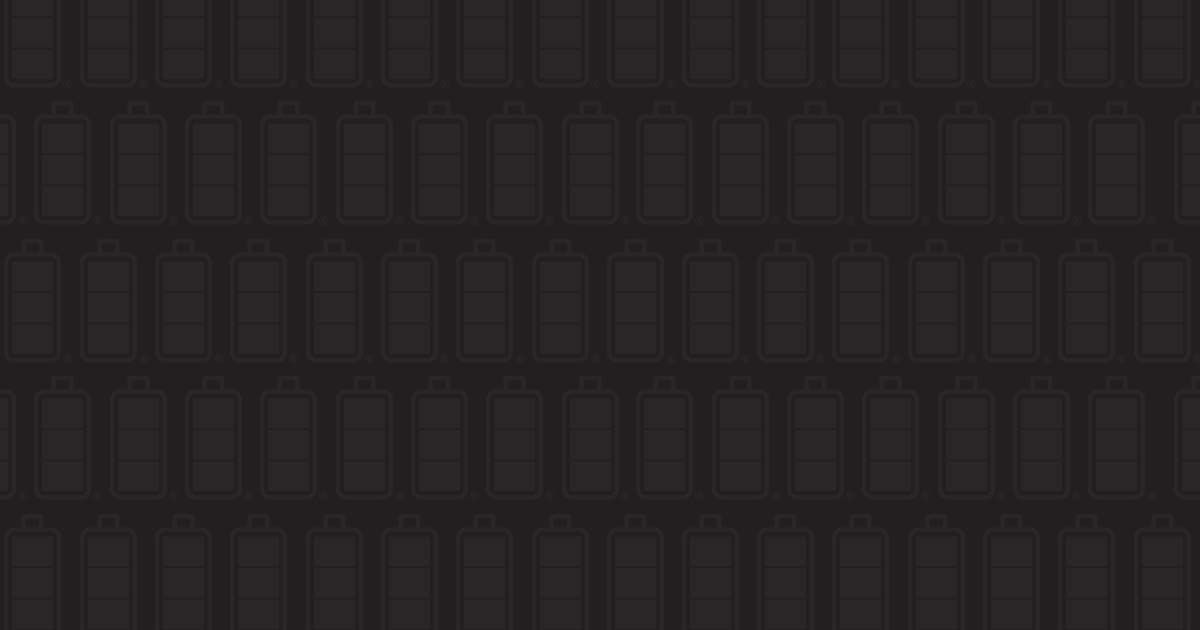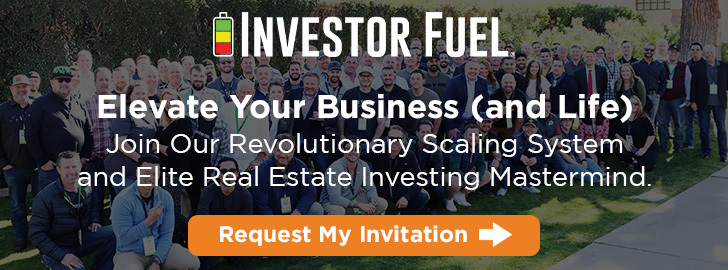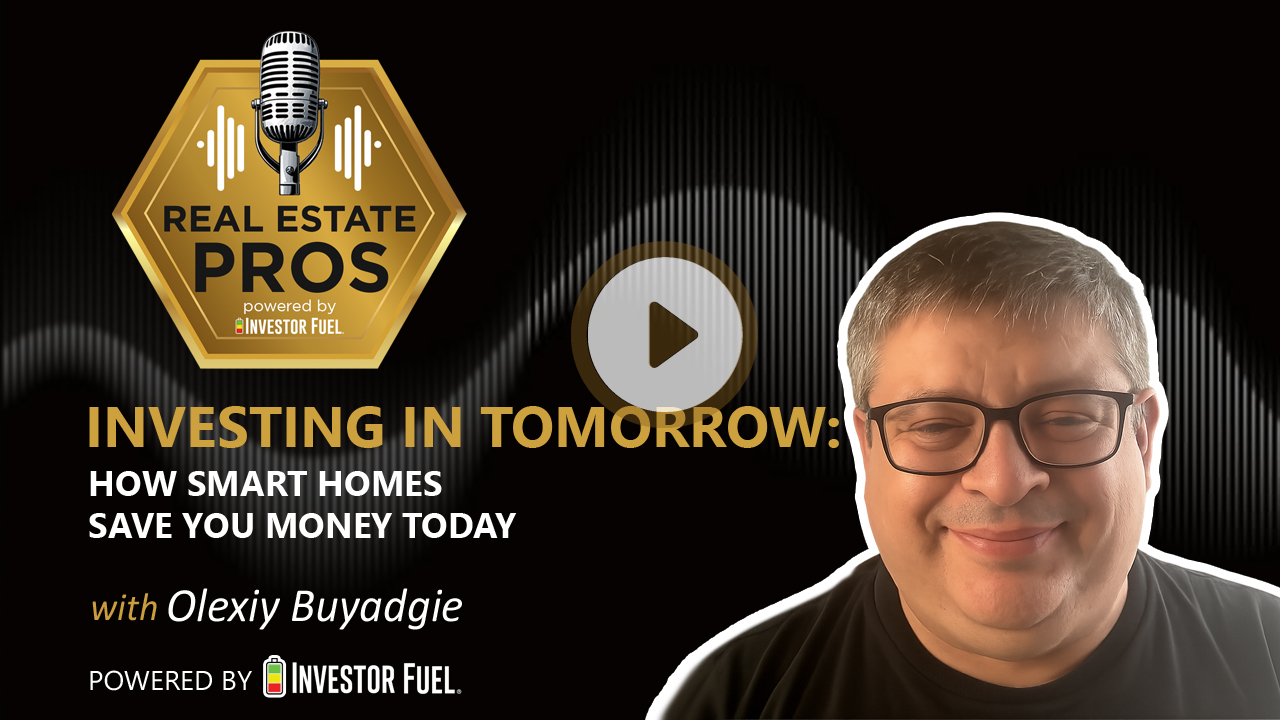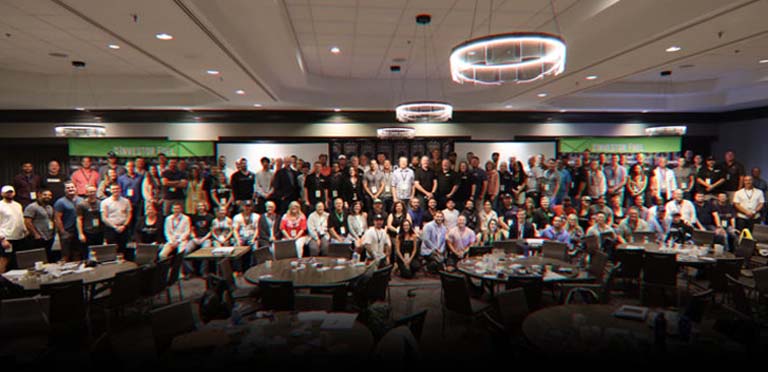
Show Summary
In this episode of the Real Estate Pros Podcast, host Michael Stansbury interviews Olexiy Buyadgie, who shares his unique background and journey from Ukraine to the United States, where he now works on innovative building technologies aimed at improving energy efficiency in real estate. Alexi discusses his work with the Department of Energy, focusing on solutions that optimize energy use in residential and commercial buildings. He emphasizes the importance of proper insulation and the integration of AI to enhance energy management. The conversation also touches on the future of eco-friendly real estate developments, including Alexi’s vision for an eco hotel and community projects.
Resources and Links from this show:
Listen to the Audio Version of this Episode
Investor Fuel Show Transcript:
Olexiy Buyadgie (00:18.297)
Welcome to the Real Estate Pros Podcast. I’m Mike Stansberry. My guest today is Olexiy Buyadgie
Boo-yah-jee. Boo-yah-jee.
Michael Stansbury (00:31.98)
And I wanna get that right, we’re gonna do that a couple times, but we’ll have some fun with that. And this broadcast is brought to you by Investor Fuel, and at Investor Fuel, we help real estate investors, service providers, and real estate entrepreneurs, two to five X their business to allow them to build the businesses they’ve always wanted and the lives they’ve always dreamed of. Alexi, thank you for being on the podcast. Let’s find out about your origin story, very unique origin story.
So we were talking a little bit about it before the podcast, but tell me how you got started in real estate, kind of where you’re from. Tell me all about that.
Olexiy Buyadgie (01:09.379)
I’m originally from Ukraine. Hi everyone. Sorry, I started from that. Originally from Ukraine, but my ancestors came from southern Bulgaria, northern Macedonia. And my famous descendant… I’m a descendant of the famous Mother Theresa. We share the same last name. It’s Buja G. And from my entire life I was…
Devoted myself to help other people’s and I started my career in the NGOs and did a lot of projects for the homeless for the People in Like refugees right and also the street kids and after that HIV AIDS positive drug addicts and so on and so forth LGBT
So, and after that I was actually devoted myself to the environment. So I was working in the State Department of the Environment and after that all my career was connected with the climate, with the environment. So I joined the engineering university and become an engineer. So I could invent and deliver something useful for
for our society, how to preserve our environment, how to save our energy, how to make us more sustainable in the era of climate change. And this is how I devote my life to. So now I’m in the United States working for the Department of Energy and California Energy Commission projects as the technology providers and…
know, technology developer and solution providers to the environmental and energy efficiency programs.
Michael Stansbury (03:10.914)
Okay, great. then, and obviously you do something in real estate as well. We talked a little bit about that kind of explain what that is and what problem that you solve in the real estate and building world.
Olexiy Buyadgie (03:23.895)
Sure, of course, building technology is one of the main focus of our research and what we do for the buildings. We are working with the building technology office of the Department of Energy and we provided and tested already several solutions that will help to optimize the, you know, the
how to say, the thermal losses of the houses and by introducing the new type of the insulation and new type of the envelopes that we developed together with the Oak Ridge National Lab. And we also invented and deployed the system of the temperature control for the household residents and for commercial buildings as well.
We call it like energy recombinator that allows to redistribute the energy flows for thermal services, which is air conditioning, space heating, water heating, if there’s a swimming pool, swimming pool heating, washing and drying. So we tested the system on the component basis and now we are
actually looking for the pilot scale demonstration in the real environment to showcase the 50 to 70 percent of the energy savings of the building.
Michael Stansbury (05:04.91)
Wow. if you were to just talk to me like I’m a second grader, right? So you’re taking this energy and redistributing it somewhere so it can be more efficient, how does that? Tell me a little bit more about that, or what the problem gets solved there.
Olexiy Buyadgie (05:24.697)
Yeah, actually today a lot of services in the households are electrified and we are using the very high-grade electricity to run these services like air conditioning or water heating or space heating which is very close to the ambient conditions. So we actually use the very valuable source of energy to basically
release it to the ambient very easily when we open the doors or through the poor insulation or through the poor windows or when we open the windows and of course we lose a lot through the attic which is responsible for 90 % of all the losses. So our idea is first of course insulation. So the proper insulation solves 90 % of the
of the heat losses. But the balance is added using the low-grade thermal energy which can be any source of renewable heat like solar heat or geothermal heat. Sometimes it’s a waste heat if it’s available at the properties. Usually it’s for the commercial buildings.
that are located close to some industrial facilities, for example, who can provide this waste heat to run this system. So we want to the thermal services in the real estate separate from the electrical services. So electrical services are going purely for the lighting, for computer charging,
for our basic home appliances, right? Instead, EV charging, for example. Instead of the thermal services, which is responsible actually for up to 70 % of all the consumption of the energy in our buildings, diverted from the electricity and run it using the thermal energy and thermal energy storage.
Olexiy Buyadgie (07:47.651)
which is quite cost efficient, very durable, very reliable in most of the zones and most of the habitats, would say, where the people are mostly concentrated. And by doing this, we will definitely lower our consumption and we’ll retain this power for any…
more important use elsewhere. So we’ll leave it in the grid. In the same time, applying our system will allow to become more user friendly because today we have a bunch of appliances which are not, you know, which are disorganized between each other. So by using the modern abilities,
machine learning and artificial intelligence will allow us to unite it under one controller, optimize the energy use depending on our needs, train our system to be more efficient, more compliant to our habits.
And at the same time, are, these kind of the controllers will allow to be, you know, more progressive, you know, in terms of meeting the modern requirements for the data usage and data application.
Michael Stansbury (09:34.062)
Yeah, is this solution mainly for larger multifamily type outfits or for residential homes or where are you solving this problem the most? What kind of variable?
Olexiy Buyadgie (09:49.957)
Sure. It’s about 100 million single-family houses in the United States. 8 to 10 million are having the swimming pool. those single-family houses are located in… 38 % of them are located in the southern states of the U.S. In the same time, there are around 6 million of commercial buildings and 5 million of…
multifamily buildings. Our system is compatible to use in all of them actually. But of course as more services are integrated in our system, the more efficient we are. So that’s why we’re first of all targeting those properties that have the swimming pool. So it’s actually a large consumer of the energy.
which is mostly gas, in the majority time, of course, goes to electricity as well. And for the multifamily buildings, for example, those who have some community pools or community laundry and drying services, that would work same perfect as for the single-family houses.
Michael Stansbury (11:12.418)
Yeah, let’s say a laundromat wants to do this, do it to that example. What is usually, and I know I’m I’m asking for a spaghetti at the wall kind of cost, but what is the cost to do these things to make it more efficient and to be able to be as efficient as possible?
Olexiy Buyadgie (11:31.695)
Since our refjet system, and you can actually find it on YouTube, the short video, REFGET, this system can, you know, since it doesn’t use any electrical power, and it has a very small amount of mechanically moving parts, usually the valves, which are
running for tens of millions cycles. we consider our system as highly reliable, highly durable, and at the same time, cost efficient at least 1.5, 2 times comparing with the set of those home appliances that our system covers and the services which is covered.
Michael Stansbury (12:28.535)
Do these appliances have to be connected to the internet for the AI to distribute or
Olexiy Buyadgie (12:34.435)
They are connected to the Internet and at the same time they are connected by pipes because we redistributing the actual heat energy among those appliances. So they have to be connected both. It’s not only electrical control, it’s the control, it’s the energy control, the actual energy control.
Michael Stansbury (12:52.802)
Wow, okay.
Michael Stansbury (12:57.676)
Right.
Olexiy Buyadgie (13:02.787)
So by hot water, hot hot media, would say. Or cooling media if we are talking about air conditioning and refrigeration. So basically, that’s the one unit. That’s like a spider with multiple connections to all our appliances. And that’s why it’s located outside of the building. So it’s easy to manage maintenance of it.
even without entering the house. you know, it’s a kind of a new approach towards the energy supply to our real estate.
Michael Stansbury (13:44.097)
Yeah, very interesting. so, and then again, you mentioned this earlier about the power, then just basically you’re so efficient that you’re not, not, the kilowatt use is just going to get, go way down based on after, after, you know, using the system and it’s R E F G E T. You Google that and get it on YouTube and kind of see how the system works. Okay.
Olexiy Buyadgie (14:07.971)
Yeah, yeah, that’s a short video that gives kind of heads up how the system works. In the same time, you know, once you invest in this system and you install it in your property, you basically don’t need to think about your energy bill for these services while enjoying it as if you are enjoying it right now.
So nothing will change. Even moreover, you will be able to control all these services individually using the voice. once the AI controller will be trained, it will be adjusting and will recognize every resident’s voice and will adjust the parameters for the best comfort of this resident, this particular resident.
to maximize his comfort. And you don’t need to come to some unit to make some adjustment, manual, you will just using your voice in order to do this adjustment. So right now this voice controller is used only for few devices like TV, like our speakers, right? We can increase the volume, we can decrease, we can…
you know, turn on, turn off the TV, but imagine that you will be able to, once you come to the shower, you will be able to turn it on using your voice without, you know, without need to turn all these valves, which are usually, right now, are of the lazy quality, most of them made of cheap plastic and we lose a lot of water in the same time when it’s leaking. So…
Michael Stansbury (15:49.56)
Turning the valve. Yeah.
Michael Stansbury (16:02.542)
No, that’s interesting, yeah.
Olexiy Buyadgie (16:03.641)
Yeah, it will be just one shower or one piece of pipe in our sink instead of faucet. It will be activated by voice.
Michael Stansbury (16:15.776)
Okay.
Let’s play devil’s advocate here. Let’s say that’s just I’m old school. I like old appliances. I don’t want to be connected to the internet of things. Is there a module where, so for instance, Alexia, I’ll tell you, one of my buddies doesn’t buy any appliance that’s not 30 years old because he can work on them and just between you and me, this is his opinion and I’ve got an agreement. They were made a lot better materials and they lasted a lot longer than the appliances that we have now.
And the other thing that he did, which was interesting, and again, this is kind of verifiable on his YouTube channel, but he actually took an energy efficient appliance and compared it to this refrigerator that’s 40 years old, and they put out the same amount of kilowatts. I know that’s just one metric. But let’s say that I’m just old school like that, but I still want to take advantage of the heat exchange, right, and to make sure that I’m getting as much fuel efficiency as possible. Is there a module where everything’s not
connected to the internet and AI.
Olexiy Buyadgie (17:19.599)
No, definitely. It’s just bringing more, how to say, making it more user-friendly for the young generations, you know, who want to have everything in the internet and who wants to have everything interconnected. But of course it can be run traditionally. you know, the only difference that you will have to tune it up by yourself and you will have a
You know kind of the controller where you have to press the buttons and have to adjust it before you will you will use it You know it can be it can be done in many in many different ways in the same time we can even You know to build the system we can even reuse the old The old you know or the current you know? Components
and to make it cheaper, for example. So we don’t need to build it from scratch, we can reuse all the components.
Michael Stansbury (18:22.968)
Right, yeah.
Michael Stansbury (18:27.534)
All right, so this is interesting. So you have a very interesting background. But an AI is just coming out. I think most people in my industry were just getting used to it. It’s fascinating. But where is it all going? Tell me something that would surprise me about where the technology and the things that you’re doing as well are going to affect us here in the not too distant future. What do you see in the horizon?
Olexiy Buyadgie (18:56.153)
You know, if… Why I came to this opinion and why I start, you know, digging deeper and exploring more on the AI stuff? Because it really gives some times, it gives some kind of the advantage over the traditional controls because it helps to optimize the system to be even more efficient. So my concern is efficiency.
And of course, if I will be able to use the AI agents, for example, I will give you the example. I would like to host the pool party, right? On some certain day, on some certain time. And the AI agent is telling me that the weather forecasts for this evening, for this particular evening, are quite supportive.
towards the outside temperature, so I need to adjust my system to be less, to consume less energy in order to heat up the pool to the temperature that I desire and my guests are desiring. So without this component, without knowing it, it will just pump a lot of energy in order to get to the point. And maybe it’s not required, maybe I can…
use something from the ambient, you know.
Michael Stansbury (20:24.118)
Yeah, yeah. it’s similar to maybe, let’s say I have a irrigation system, right? But it rains for, it’s going to rain. And so you don’t have to worry about the irrigation manually doing the controls because they have a little bit of that technology now, but now you’re getting real-time information about your location, your geo location, and it’s talking to the irrigation system and you’re just kind of hands off. I love it. That’s, that’s really, really cool.
Olexiy Buyadgie (20:52.099)
Yeah, so something practical. like when it helps in something practical. And it really helps. It has its potential to do that. I’m not speaking about something that it can substitute people, maybe later, maybe, you know, but we cannot dream about that as of now. Even though there are a of robots, there are a lot of
Michael Stansbury (21:19.171)
Yep.
Olexiy Buyadgie (21:22.117)
you know, optimization that the AI developers are trying to do with to make these robots as close as humans, of course. Those who are dealing with some intellectual activity and have some emotions and empathy, I don’t think that the robots will be able to substitute.
Michael Stansbury (21:48.143)
They won’t robots They can they can certainly say the words to seem empathetic But yeah, but they’re not human. That’s that’s great. Well, Alexi. It’s it’s very interesting. This is a very interesting topic. So In the real estate world, do you do any real estate investing at all yourself? Or what does that look like in? We’re so investor fuel were real estate pros podcast and we always like to dig into that
Olexiy Buyadgie (21:54.852)
Yeah.
Michael Stansbury (22:15.766)
So what does that look like in your background? And where are you located, by the way?
Olexiy Buyadgie (22:19.971)
I’m located in the East Bay, San Francisco, and I’m really interested in the real estate. Especially my dream is to build the new type of the hotel. I mean, when I’m talking new type, it’s not only the energy stuff. It’s a kind of the new type of services that the tenants, residents, visitors can get out of it.
Of course it will be truly an eco hotel, it will be completely off the grid, so will not consume any power or any energy source from external. But there are some kind of features that I want to use that will attract visitors just to stay in this hotel, just to have this experience.
So I believe that this hospitality type of business is more interesting for me, at least for the time being. I’m of course, I mean, if I were, if I would be these civil engineer or developers, you know, I would probably looking towards building some single family houses, but I’m more about some kind of
Non-trivial developments, know project so that’s why the echo Hotel and echo village is something that is in my Future plans and actually for the echo village. We already developing this project in Sonoma County Yeah, and we would like to have more we would like to make like a syndicate there so to host host a lot of
Michael Stansbury (24:07.49)
Okay.
Olexiy Buyadgie (24:17.429)
you know investors and partners into this project because what we are planning to build we’re planning to build kind of a prototype of the city of the future there. Yeah
Michael Stansbury (24:29.472)
I like it. I like it. That’s exciting. Well, Alexi, how do people reach out to you? What’s your how does people find you in San Francisco? What does that look like online?
Olexiy Buyadgie (24:39.365)
Usually I’m not a very good user of the social networks, In this one I’m the old-school guy as well. But I’m using them mostly as my phone book or just contact book to reach out to certain people. But posting something and being more sociable, I just don’t have time for that.
Michael Stansbury (24:48.856)
Ha
Michael Stansbury (25:08.386)
I hear you. Yeah, you’re doing a lot. Yes, sir.
Olexiy Buyadgie (25:09.189)
Yeah, that’s the only reason probably.
Michael Stansbury (25:13.036)
Yeah, but you got a great LinkedIn profile that I that I’ll put on the show notes as well. Yeah.
Olexiy Buyadgie (25:15.723)
Yeah, sure. LinkedIn profile is there. Everybody can connect me through this. My email is buyadgie at w-i-l-s-o-m-e-t dot org. So I do have a Facebook profile as well under my name and Twitter. Sorry, it’s X right now.
But I’m still using it as a Twitter Yeah, probably that’s it. I even don’t have an Instagram because Instagram requires some kind of activities otherwise You know you cannot use it too much
Michael Stansbury (25:45.347)
Right.
Michael Stansbury (25:57.068)
Yeah, you’re good. think you’re good. I actually like that speed better than my speed, which is I got too much social media. hey, Alexi, thanks again for being on the show. And I appreciate this great information. And I really enjoy what you’re doing. You’re solving a lot of problems out there. Hope everyone enjoyed today’s shows. We’ll see you on the next episode. Thank you for joining. And like and subscribe to learn more about Investor Fuel. Thanks, everybody.
Olexiy Buyadgie (26:22.245)
Thank you. Thank you. Bye bye.







